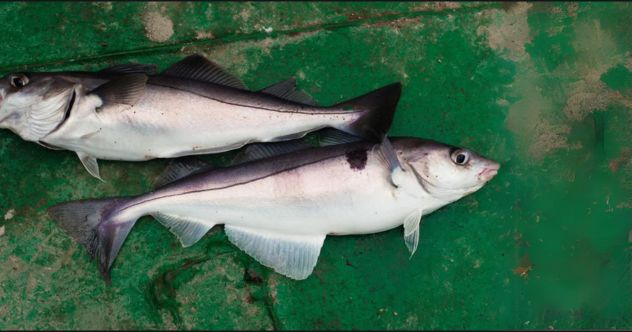Miracles involving food have always been very popular—just ask the five thousand who Jesus miraculously fed with just five loaves of bread and two fish. While researching my book of food folklore, I discovered many saints have expressed their blessed nature through the medium of food.
Here are ten times saints manifested their divine abilities at the dinner table.
Related: 10 Saints Who Led Unsaintly Lives
10 St. Neot’s Fish

Neot was a 9th-century English monk of diminutive stature, standing just 4 feet (1.22 meters) tall, who retired from his monastery to live as a simple hermit in seclusion. His holy nature spread his fame, however, so Neot was visited by people to ask for his wisdom, including King Alfred the Great. Word of his miracles also led to Neot being widely sought out.
One of his most famous miracles was that of the fish. It is said that one day, Neot was visited by an angel who placed three fish in his well and told him that he was allowed to remove one fish per day and eat it. Neot did this and found that when he visited the well the next day, there were still three fish. This miraculous supply of seafood continued for many years until an accident involving his servant.
Neot fell ill, and the servant, not knowing the angelic arrangement, took two fish from the well to give Neot a bigger meal. Neot saw the pair of fish on his plate and cried out in shock. He ordered the servant to return the fish to the well immediately. When the cooked fish splashed into the water, they sprang back to life. This is why Neot became the patron saint of fish.[1]
9 St. Blaise’s Fishbone
Blaise was a physician and Christian who lived in Turkey during the 3rd and 4th centuries. Being alive during a period of Roman persecution, Blaise found himself arrested and hauled off to prison. According to legend, it was while being led in chains that a mother stopped Blaise to ask for his aid because her son was choking to death on a fishbone. Blaise blessed the child’s throat, and the bone was immediately removed. The young man was saved.
Blaise did not have a good time in prison and was ultimately martyred for his faith. He did at least get made a saint—the patron saint of throats (among other things). Each year, on the saint’s day, a service known as the Blessing of the Throats was given in the saint’s honor. This involved a special prayer and a pair of crossed candles being held against the throat of anyone suffering from an illness of the throat.[2]
8 St. Hyacinth’s Pierogi
Hyacinth was a 13th-century Polish priest sent from Rome to perform missionary work in Poland and northern Europe. This turned out to coincide with the Mongol invasions of the area, and one of his miracles involved him carrying a heavy statue of the Virgin from a church in Kyiv (formerly Kiev) before it could be captured.
When Hyacinth visited a village, he found that a storm had recently raged through the area and destroyed all the crops. The people were starving, so Hyacinth got to work. He prayed to God, and the ruined crops all rose from the ground and ripened. In return for this divine bounty, the villagers made pierogi from the crops and gave them as a gift for the holy man who had saved him. Others say that Hyacinth had fed the crowd pierogi to save them.
In Polish, there is a saying that goes, “Swiety Jacek z pierogami!” meaning “St. Hyacinth and his pierogi!”[3]
7 St. David’s Leeks
Wales is synonymous with leeks. Each St. David’s Day, the national day of Wales, Welsh people proudly wear leeks—a somewhat unusual piece of fashion. How this tradition came into existence involves an act of warfare on St. David’s Day.
According to a legendary account, it was while Welsh soldiers were preparing for a battle that it was realized that in the confusion of the fight, it would be hard to tell who was Welsh from who was an enemy. St. David told the Welsh to place a leek in their helmets, as leeks were growing in a garden nearby. The Welsh triumphed and offered thanks to St. David for his aid, and leeks later became the symbol of the saint.[4]
6 St. Nicholas’s Chicken
Nicholas of Tolentino was a priest in 13th-century Italy who was renowned for his visions and miraculous activities. As part of this ascetic lifestyle, he refused to eat any meat and lived solely on vegetables.
This vegetarianism was noble but thought to be a little extreme by his fellow priests, especially when he fell seriously ill. Monks at the time would provide meat to those in their care to try and strengthen them. While Nicholas was on his sickbed, the monks brought him a pie containing two chickens, despite his refusal to eat meat. Nicholas was not to be tricked, however. He smelled the chickens in the pie and immediately blessed the pie. The birds, springing back to life, launched themselves from the pie and flew out the window.
This was a popular tale, and several images of the saint with a bird on a plate exist. In a small image painted by Raphael, the two birds can be seen in mid-air while the saint reclines in his bed.[5]
5 St. Zita’s Bread
Zita was a girl born in the 13th century near Lucca in Italy. At a young age, she was sent to work as a maid for a wealthy local family and would serve in their home for fifty years. When she first joined the house, the other maids were jealous of her and used to mock and punish her—treatment that Zita apparently took with beatific calm.
Zita was well beloved by the poor nearby because she gave away most of her earnings and helped those in need to get food. She would also take bread from the house where she worked and distribute that in times of difficulty. One day, the other maids reported this to the mistress of the house, and she confronted Zita. With the bread concealed under her apron, Zita was asked if the accusations were true. Zita denied it, and the mistress demanded she reveal what she was hiding. When Zita let go of the folds in her apron, a wave of fragrant flowers poured out.
Other legends say while Zita was out in the town performing acts of charity, angels would visit the kitchens of the house to ensure that all her cooking was performed. After Zita died, she was made the patron saint of servants.[6]
4 St. Peter’s Haddock
Haddock is one of the most popular fish to eat in Scotland. They have two distinctive dark marks on them, so legends grew around why these fish look like they do, with the British creating two very different myths.
The first involves St. Peter and claims to have the Bible on its side. In the Gospel of Matthew, Jesus tells Peter to go down to a lake and cast in a fishing line, and the first fish pulled in will have a coin inside it. Peter apparently did this, and the fish he caught was marked forever after with his fingerprints.
The alternative story is more diabolical. One day, the Devil dropped his hammer in the sea and thrust his hand in to retrieve it. Instead of his tool, the Devil grasped a haddock, and his scalding hands burned a brand onto the fish, which can still be seen to this day.[7]
3 St. Ciaran’s Oats and Milk
Ciaran of Clonmacnoise was one of the early apostles of Christianity in Ireland in the 6th century, and many miracles are attributed to his mission.
In one of these, famine is caused by a period of unusual cold that destroys all of the wheat used to make fine bread. All that was left was a small amount of oats which Ciaran harvested, and he gave thanks to God for even this small mercy. As he spoke his prayer, he felt the bag get heavier, and when he opened it, the oats had been exchanged for a large quantity of wheat. The wheat was milled into flour and used to bake a vast number of loaves, which were the best anyone had ever eaten. It also cured illnesses and the sick.
Another miracle involves the saint being followed by a cow and calf from his family’s farm, even though the family had refused to give him a cow. Not wanting to steal, Ciaran drew a line in the dirt and forbade the cow to cross it. The cow was unable to pass, so it turned back for home – but the calf carried on and lived with Ciaran from then on. When this calf grew up, it produced so much milk that it could supply the entire monastery. Milk and oats? They definitely did not go short of porridge.[8]
2 St. Brigid’s Bathwater Beer
St. Brigid is one of the patron saints of Ireland, and very little is known of her historical life in the 5th century. Some scholars have even doubted whether she really existed. They suggest that she is a Christianized version of the Celtic goddess Brigid. Either way, Brigid is supposed to have performed wild miracles. As a child, she gave away all her mother’s butter to the poor, but her prayers filled the family supplies when it was noticed the butter was gone.
One of her strangest miracles came when Brigid was working with lepers. Beer was thought to be beneficial for the sick because it was so nutritious and was often cleaner than other supplies of liquid. To Brigid’s horror, it was found that the leper colony was entirely out of beer! So Brigid took the water, which would be used to bathe the ill, and turned it into the most brilliant beer ever drunk. In some versions, the miracle is even more extreme as Brigid uses dirty bathwater which has already had lepers in it.
Brigid must have really liked beer because a 10th-century poem begins with her saying:[9]
“I’d like to give a lake of beer to God.
I’d love the heavenly
Host to be tippling there
For all eternity.”
1 St. Juthwara’s Cheesy Chest
Juthwara was a pious young lady who lived around the 7th century in England. As in many tales, her stepmother was wicked and never liked Juthwara, but she hid her hatred while Juthwara’s father was alive. Once he died, however, she sought to destroy her stepdaughter.
Juthwara was sorely afflicted by the passing of her father and developed some sort of pain in her chest. Her stepmother offered a medical cure to ease her illness. Juthwara had to take some soft cheeses, place them on her breasts, and let the cheese soothe her sickness.
While Juthwara was resting with cheese on her chest, the stepmother went to Juthwara’s brother and told him that Juthwara was sleeping with men and had gotten pregnant—and having milky breasts would prove the truth of the accusation. The brother was outraged that Juthwara would shame him in this way and confronted her. When he inspected her chest, he found it wet and smelling of milk, so he cut off Juthwara’s head.
Juthwara fell to the ground dead—but then stood up and picked up her decapitated head. She strolled into a church. Juthwara’s brother apparently repented of his murderous act and became a monk. So that’s okay. What happened to the stepmother, or the cheeses, is not recorded.[10]
